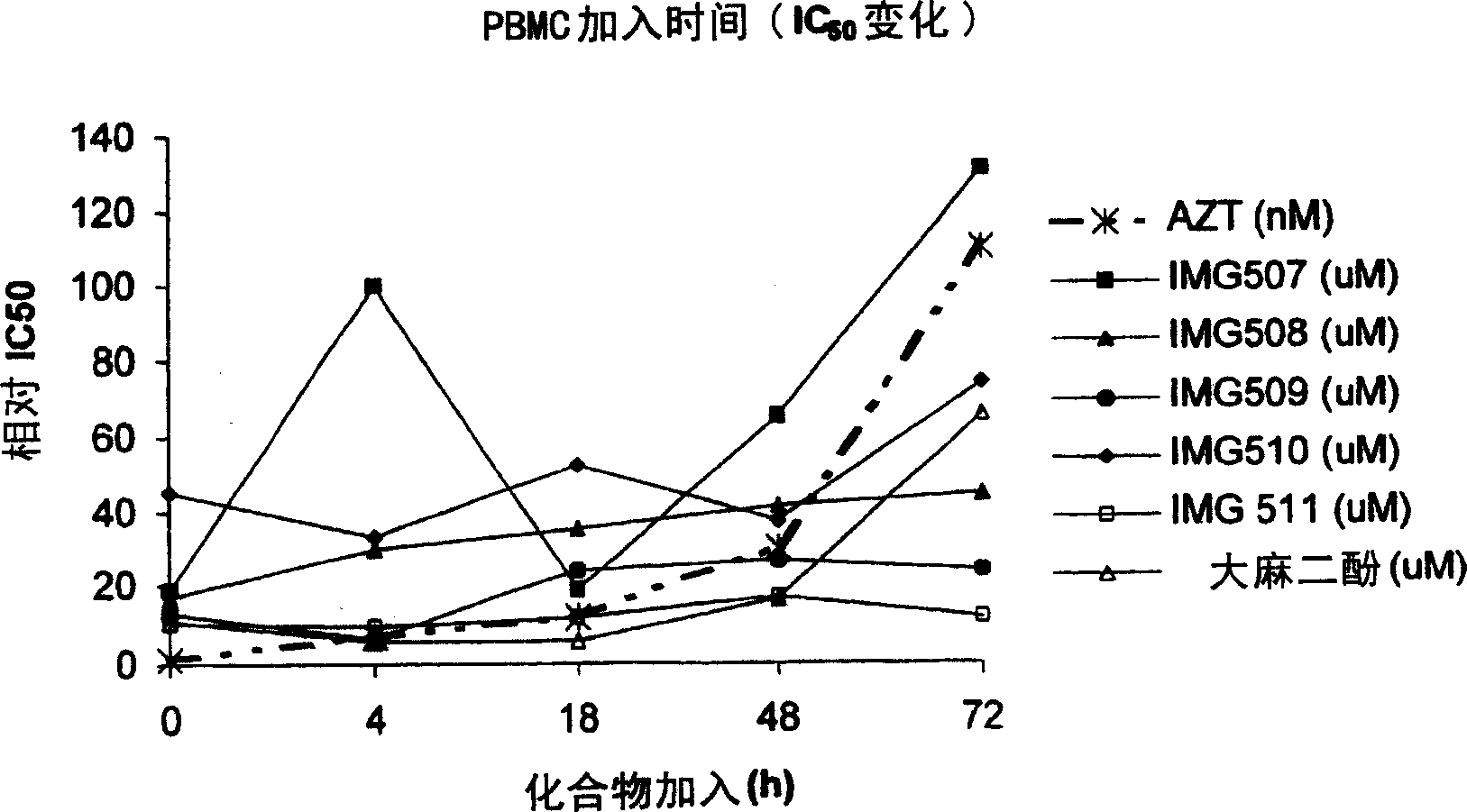Topical formulations of resorcinols and cannibinoids and methods of use
A technology of resorcinol and cannabinoids, applied in the field of HIV infection, can solve the problems of increasing the risk of HIV transmission and lack of recognition
- Summary
- Abstract
- Description
- Claims
- Application Information
AI Technical Summary
Problems solved by technology
Method used
Image
Examples
preparation Embodiment 1
[0420]A mixture of 2,6-dimethoxyphenol (73.4 g, 0.48 mol), 2,6-dimethyl-2-heptanol (69.0 g, 0.48 mol) and methanesulfonic acid (95 mL) was stirred at 50 °C 3 hours, then stirred overnight at room temperature. The mixture was poured into ice water (600 mL) with stirring. The mixture was extracted with dichloromethane (2 x 200 mL). The extract was washed with water, saturated aqueous sodium bicarbonate and saturated aqueous sodium chloride, and dried over anhydrous sodium sulfate. The solution was concentrated under reduced pressure to obtain an oily product (130 g, 96%). Analysis of the substance (MS(FAB) m / z 281(MH) + ; 1 H NMR (CDCl 3 )δ0.80(d, 6H), 1.0-1.1(m, 4H), 1.27(s, 6H), 1.40-1.60(m, 3H), 3.89(s, 6H), 5.36(s, 1H), 6.54 (s,2H)) is shown to be 4-(1,1,5-trimethylhexyl)-2,6-methoxyphenol (hereinafter referred to as IMG-502):
[0421]
preparation Embodiment 2
[0423] Crude 4-(1,1,5-trimethylhexyl)-2,6-dimethoxyphenol (130 g, 0.46 mol) from Example 1 was dissolved in anhydrous CCl 4 (100 mL) was cooled in an ice bath, and diethyl phosphite (70 mL, 0.54 mol) was added. To this stirred mixture was added triethylamine (75 mL, 0.54 mol) dropwise at a controlled rate to maintain the temperature of the reaction mixture below 10°C. The reaction mixture was stirred in the ice bath for 2 hours and at room temperature overnight. The mixture was then diluted with dichloromethane (200 mL), washed with water, 4N aqueous sodium hydroxide solution (100 mL), 1N aqueous hydrochloric acid solution (125 mL), water and saturated aqueous sodium chloride solution. The extract was dried over anhydrous sodium sulfate, and concentrated under reduced pressure. The crude product was purified by silica column chromatography eluting with cyclohexane:EtOAc (7:1-3:1 gradient) to afford 103 g (54%) of product as a colorless waxy oil. Analysis of the substance (M...
preparation Embodiment 3
[0426] 4-(1,1,5-trimethylhexyl)-2,6-methoxyphenyl diethylphosphate (82 g, 0.197 mol) from Example 2 was dissolved in Et 2 A solution in O (175 mL) and THF (35 mL) was slowly added to liquid ammonia (450 mL) contained in a three-necked vessel equipped with a mechanical stirrer, thermometer, dry ice condenser, and pressure-balanced addition funnel, while Small pieces of freshly cut -lithium wire (2.8 g, 0.40 g-atom) were added at a rate to maintain the blue color. The reaction mixture was stirred for an additional 1 h, then the reaction mixture was stirred by adding saturated NH 4 Cl aqueous solution (22 mL) was used to quench the reaction. Diethyl ether (220 mL) was added and the ammonia was evaporated overnight. The residue was treated with water (220 mL). The layers were separated and the ether layer was washed with 4N NaOH (200 mL), water (2 x 200 mL) and saturated aqueous sodium chloride. The organic extracts were dried (MgSO 4 ) and concentrated under reduced pressure...
PUM
 Login to View More
Login to View More Abstract
Description
Claims
Application Information
 Login to View More
Login to View More - R&D
- Intellectual Property
- Life Sciences
- Materials
- Tech Scout
- Unparalleled Data Quality
- Higher Quality Content
- 60% Fewer Hallucinations
Browse by: Latest US Patents, China's latest patents, Technical Efficacy Thesaurus, Application Domain, Technology Topic, Popular Technical Reports.
© 2025 PatSnap. All rights reserved.Legal|Privacy policy|Modern Slavery Act Transparency Statement|Sitemap|About US| Contact US: help@patsnap.com



